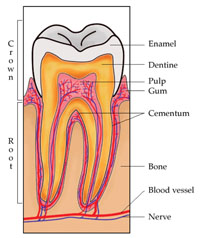Teeth
Humans normally produce two complete sets of teeth in our lifetime. The first set are called 'baby' teeth or 'milk' teeth and there are 20 of them. They usually begin to emerge from the gums at the age of four to six months, but occasionally much earlier. The second set, consisting of 32 permanent teeth, begin to replace the first teeth around the age of six years. If a permanent tooth is damaged or lost, the body cannot replace it. Teeth are the toughest structures in the body – much stronger than our bones. They are covered in tooth enamel, the hard white shiny substance which gives great strength to the tooth (Figure 6.2).

What do you think is the purpose of tooth enamel and what does it enable us to do?
The enamel protects teeth from penetration by bacteria, so it prevents tooth decay. It also strengthens the teeth and stops them from wearing down, so we can bite off chunks of food and chew it to a soft mass throughout our lives.
There are various tooth shapes for different jobs. For example, when chewing, the upper teeth work together with the lower teeth of the same shape to bite, chew and tear food apart. According to their shape and function the adult teeth have got different names (Figure 6.3 and the bullet points below it).

- Incisors: there are eight incisors in the front of the mouth (four on the top and four on the bottom). They have sharp, chisel-shaped crowns that cut food.
- Cuspids: (or canine teeth): there are four cuspids, one next to each incisor. They have a pointed edge to tear food.
- Bicuspids (or premolars): the four pairs of bicuspids are located next to the cuspids. They crush and tear food.
- Molars: there are twelve molars, in sets of three, at the back of the mouth. They have wide surfaces that help to grind food.